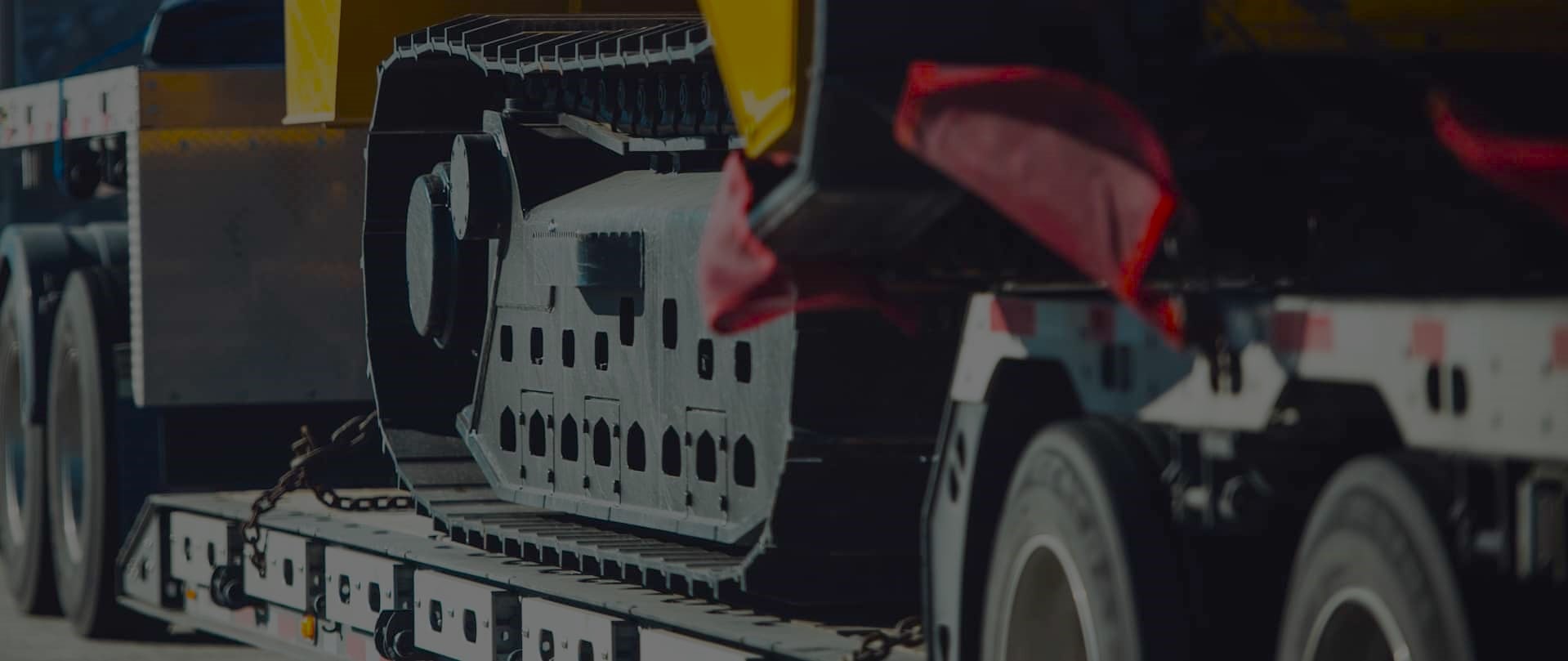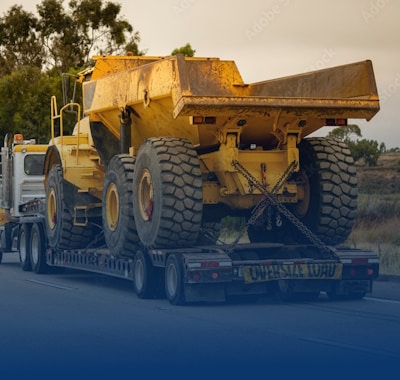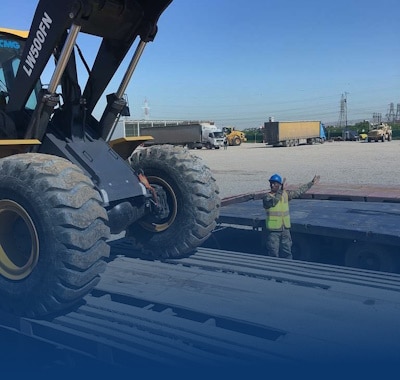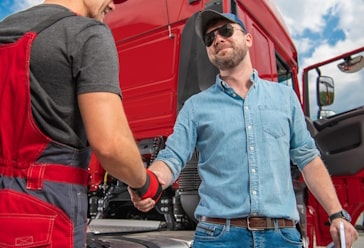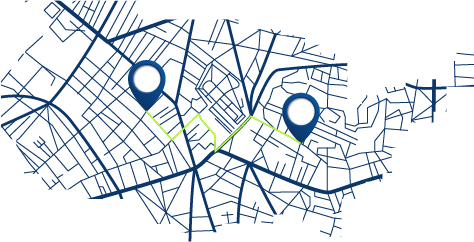Haul Skid Steers and Wheel Loaders with Flatbed Trucking
Freedom Heavy Haul can offer expedited Pickup and Delivery for any size shipment anywhere in the USA. Contact us today for No Hassle, No Pressure Pricing.
Flatbed trucking is a safe and efficient way to move construction equipment. This includes Caterpillar skid steers and John Deere wheel loaders. It helps reduce downtime and keeps your equipment in good shape.
Flatbed trailers have open access, making it easy to load and unload big machinery. Companies use special trailers like step-deck or lowboy for different sizes and weights.
When picking a transport service, look at trailer types, weight limits, and rules for routes. Good planning means your equipment gets to its destination on time and in perfect condition.
Understanding Flatbed Trucking for Skid Steers and Wheel Loaders
Choosing the right trailer for transporting skid steers and wheel loaders is key. It ensures safe and efficient delivery. Proper planning helps avoid delays and meets all regulations. Here are important factors to think about when shipping wheel loaders or similar equipment.
Types of Flatbed Trailers Available
Specialized flatbed transport uses trailers made for specific loads. You’ll find:
- Standard flatbeds: Great for low-clearance equipment like skid steers.
- Drop-deck trailers: They have a lower deck for taller wheel loaders.
- Extendable flatbeds: These adjust to fit oversized machinery.
| Trailer Type | Max Weight Capacity | Best For |
|---|---|---|
| Standard Flatbed | 48,000 lbs | Compact equipment |
| Drop-Deck | 55,000 lbs | Tall machinery |
| Extendable | 60,000 lbs | Oversized loads |
Weight and Size Considerations
Getting the right measurements is vital to avoid overloading and legal trouble. Always check the equipment’s height, width, and weight before booking. For instance, Illinois needs permits for loads over 80,000 lbs. Local guidelines help understand state-specific rules.
Equipment Loading Requirements
Proper loading keeps both the equipment and drivers safe. Here’s how to do it:
- Place the load in the center for balance.
- Use heavy-duty straps or chains that can handle the equipment’s weight.
- Attach safety flags or lights for wide loads.
Specialized flatbed transport services often offer professional loading help. They make sure everything follows federal and state standards.
Benefits of Professional Heavy Equipment Transportation
Choosing professional heavy equipment transport means your gear gets to its destination safely and on time. Skid steer trucking services use special trailers and expert logistics to cut downtime. Reliable wheel loader transport providers secure your equipment well and plan the best routes.
- Safety First: Trained drivers handle loading, securing, and navigating regulations.
- Cost Savings: Avoid fines or delays with compliant permits and insurance.
- Efficiency: GPS tracking and real-time updates streamline delivery timelines.
“Partnering with a professional flatbed hauling company reduces risks and ensures equipment arrives in pristine condition.”
| Service Type | Key Benefit | Best For |
|---|---|---|
| Skid Steer Trucking Services | Precision handling | Compact machinery |
| Reliable Wheel Loader Transport | Heavy-duty security | Construction sites |
| Professional Flatbed Hauling | Versatile loading | Oversized equipment |
Companies like V&M Towing follow all state and federal rules. Freedom Heavy Haul makes sure skid steer transport is easy. Working with a pro flatbed hauling company means your equipment is in good hands.
Essential Safety Protocols for Equipment Transport
Safety is key when hauling heavy equipment. Moving skid steers or wheel loaders needs careful planning. This ensures the equipment arrives safely and on time.
Good planning reduces risks and protects your investment. It also keeps the roads safe for everyone.
Securing Methods and Equipment
Securing skid steers and wheel loaders on a flatbed is critical. Here are some tools to keep them in place:
- Grade-70 chains with ratchet binders for heavy-duty anchoring
- Nylon straps with working load limits exceeding equipment weight
- Anti-slip mats and wheel chocks for lateral stability
Always check the tightness of these before you leave.
Weather Considerations
Weather can affect transporting construction equipment. High winds and rain can be dangerous. Use apps like Weather Underground to stay informed:
- Plan to reschedule during extreme weather
- Use waterproof tarps to protect hydraulic systems
- Slow down by 20-30% in wet conditions
Risk Management Strategies
Preventing accidents is a top priority. FMCSA data shows proactive planning can prevent 60% of incidents. Here are some steps to take:
- Do pre-trip checks on trailers and securing gear
- Plan routes to avoid low bridges or weight-restricted roads
- Use GPS for real-time tracking and quick response
| Protocol | Tools/Methods | Purpose |
|---|---|---|
| Load Securing | Chains, straps, chocks | Prevent shifting |
| Weather Prep | Tarps, forecast apps | Reduce damage risk |
| Route Planning | GPS, road databases | Avoid hazards |
Working with certified transport services adds safety. They have trained staff and follow strict rules. Regular checks and driver training also help keep equipment safe during transport.
Cost Factors in Heavy Equipment Shipping
Understanding the costs of moving heavy machinery is key to better budgeting. The price for shipping skid steers or wheel loaders varies based on several factors. Let’s explore what affects your final cost.
- Equipment specifications: The weight, size, and attachments needed affect the trailer and labor needed.
- Distance and route: Longer trips cost more in fuel. Routes with tolls, permits, or tough terrain add extra fees.
- Seasonal demand: Busy construction seasons can raise prices because of fewer trailers available.
“Planning ahead reduces costs. Booking specialized flatbed transport early helps secure competitive rates and avoids last-minute surcharges.” – Transportation Expert
Specialized flatbed transport might seem expensive at first. But it offers long-term benefits. Companies that handle skid steers or wheel loaders provide custom solutions. This includes reinforced trailers or hydraulic ramps for safe transport.
These services help avoid damage or delays, which can increase costs. Always ask for detailed quotes to compare costs. For shipping wheel loaders, check if permits or pilot cars are included. Trustworthy companies offer clear pricing and support, ensuring your equipment is safe.
Preparing Your Equipment for Transport
Getting your machinery ready for transport is key. It ensures it arrives safely and on schedule. Whether you’re using skid steer trucking services or reliable wheel loader transport, following these steps helps. It reduces risks and makes the process smoother.
Pre-Transport Inspection Checklist
Begin with a detailed inspection. Look for:
- Fluid leaks (oil, coolant, hydraulic fluid)
- Loose bolts, attachments, or debris
- Tire pressure and structural integrity
Clean your equipment to avoid transporting harmful materials. A professional flatbed hauling company might not accept dirty shipments.
Documentation Requirements
Get your paperwork in order. You’ll need:
- Proof of ownership or authorization to transport
- Weight certificates and dimensions
- Permits for oversized loads (if applicable)
Reliable wheel loader transport providers usually ask for signed contracts. These outline delivery times and who’s responsible for what.
Insurance Considerations
Check if you have insurance for damage or delays. Most skid steer trucking services have basic liability. But, you might need extra coverage for valuable equipment. Make sure:
- Carrier’s insurance limits and exclusions
- Your own equipment insurance coverage
“Insurance isn’t just a formality—it’s peace of mind. Partner with a professional flatbed hauling company that prioritizes transparency in their policies.”
Talking clearly with your transporter is important. It makes sure everyone knows about risks and protections.
Specialized Loading and Unloading Techniques
Moving heavy machinery needs precision. Skilled operators use tools like hydraulic ramps, mobile cranes, and low-profile trailers. These tools help load skid steers or wheel loaders safely, without damage or injury. They ensure stability, which is key when using flatbed trucking for uneven terrain.
- Ramp systems: Adjustable ramps fit different trailer heights, making transitions smooth.
- Crane-assisted lifts: Great for big or delicate equipment, reducing ground contact.
- Wheel chocks and tie-downs: Keep equipment from shifting during transport, a vital step.
“Proper loading isn’t just about getting equipment on the truck—it’s about ensuring every component stays secure from start to finish. A single oversight can lead to costly delays or accidents.”
Transport services for construction equipment include pre-loading checks. These checks verify weight distribution and secure points. For example, spreader bars balance loads, and soft straps protect fragile parts. Working with experienced teams ensures safety, following Thompson Tractor’s safety guidelines.
Safety is more important than efficiency. Whether it’s a compact skid steer or a huge wheel loader, using specialized techniques is key. It reduces risks and keeps projects on track. Relying on professionals ensures your equipment is safe and your project stays on schedule.
Tracking and Communication During Transport
Keeping your machinery safe and on time is key. For flatbed transportation for skid steers or equipment shipping for wheel loaders, it’s all about clear communication. Today’s logistics use tech and clear rules to reduce risks and keep everyone updated.
Real-Time Updates
Top services use GPS and digital tools to share where your stuff is. You get:
- Quick alerts for any delays or changes in route.
- Mobile apps for updates on when it will arrive.
- Proof of delivery with photos and times.
This is super important for planning site work, like with specialized flatbed transport for big loads.
Emergency Response Protocols
Even with the best plans, things can go wrong. Good transporters have backup plans for accidents, bad weather, or breakdowns. A logistics expert says:
“Our teams are ready to act fast. If there’s a flat tire or a storm, we tell you right away, change the route, and send help quickly.”
These plans help keep equipment shipping for wheel loaders on track, saving time and money. Working with a specialized flatbed transport company means your stuff gets there safely, and you can relax.
Compliance and Regulatory Requirements
Transporting heavy machinery like skid steers or wheel loaders needs strict legal rules. Working with a professional flatbed hauling company ensures you follow these rules. This helps avoid delays or fines. Let’s look at the main rules for moving equipment.
Federal Transport Regulations
The Federal Motor Carrier Safety Administration (FMCSA) sets the basic rules for moving heavy equipment. These rules include weight limits (usually 80,000 lbs gross), how to secure the load, and limits on how long drivers can work. For example, skid steer trucking services must use DOT-approved chains or straps to keep the load from moving during transport.
FMCSA §392.9: “Cargo must be firmly immobilized or secured on or within a vehicle.”
State-Specific Requirements
Local laws add more rules. In Texas, you need to show “oversize load” signs for anything wider than 8.5 feet. California requires that transporters follow emission rules. A reliable wheel loader transport provider keeps up with these rules to make sure trips go smoothly across state lines.
Permit Requirements
Loads that are too big or too heavy usually need special permits. Here are some common reasons:
- Equipment wider than 8.5 feet
- Loads taller than 13.5 feet
- Single-item weights exceeding 80,000 lbs
| Permit Type | When Required | Example States |
|---|---|---|
| Annual Oversize | Frequent multi-state transport | Florida, Ohio |
| Single-Trip | One-time oversized haul | Colorado, Oregon |
| Superload | Weight exceeds 150,000 lbs | Nevada, Pennsylvania |
Understanding these rules takes expertise. Top skid steer trucking services take care of permits, check routes, and arrange for escort vehicles. This lets you focus on your project’s timeline. Always check a transporter’s compliance record before you book.
Partner with Expert Heavy Equipment Transporters for Peace of Mind
Choosing professional flatbed trucking for skid steers and wheel loaders means your equipment gets to its destination safely and on time. These transporters use their knowledge and tools to handle complex logistics. They take care of everything from securing Caterpillar loaders to dealing with state permits.
They focus on safety, using special tie-downs for Bobcat skid steers and checking the weight of John Deere machinery. They work with insurance companies like Nationwide or Progressive to cover your equipment during transport. Their drivers follow OSHA rules, which helps protect your business.
These services use GPS tracking to keep you updated, following Section 8’s guidelines. They plan routes carefully to avoid low bridges or roads with weight limits. This helps prevent delays in important projects.
Companies like J.B. Hunt or Schneider National offer tailored solutions for moving your equipment. They know the size and weight of different machines, making sure they follow DOT rules. By choosing them, you can focus on your work and avoid unexpected costs.
Professional transport is more than just getting your equipment there. It’s about protecting your assets and reputation. With clear prices, 24/7 support, and a good track record, these services make moving equipment easy. Look for partners with FMCSA certifications and positive reviews to have peace of mind.
